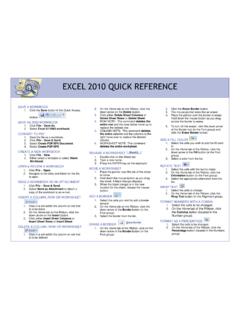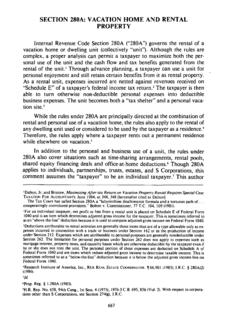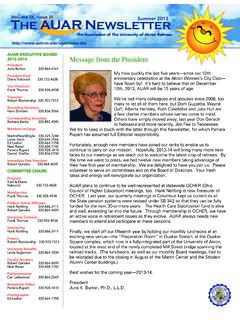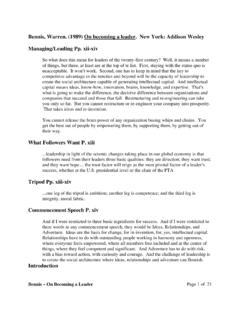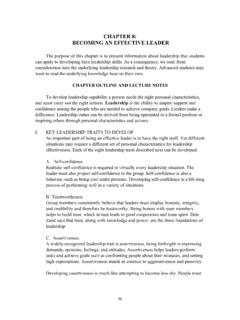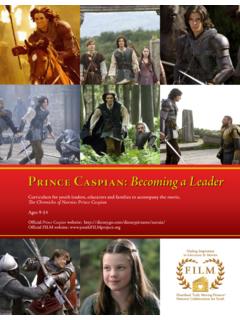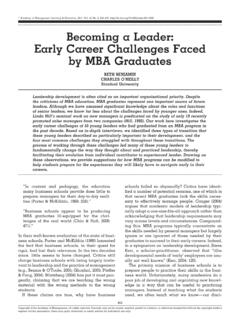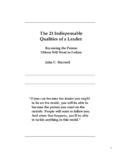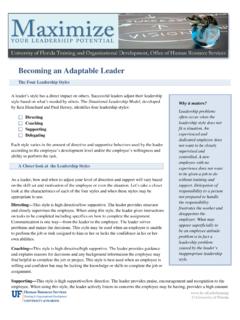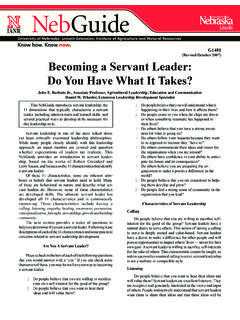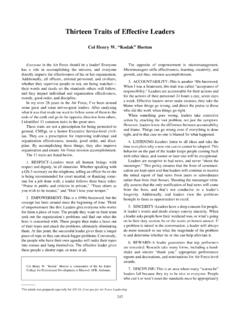Transcription of INTRODUCTION TO ARMY LEADERSHIP - University of Akron
1 Section1 LEADERSHIP TrackKey Points1 What Is LEADERSHIP ?2 The Be, Know, DoLeadership Philosophy3 Levels of army Leadership4 LEADERSHIP Versus Management5 The Cadet Command LEADERSHIP Development Program INTRODUCTION TOARMY LEADERSHIPAll my life, both as a soldier and as an educator, I havebeen engaged in a search for a mysterious nations seek it constantly because it is the key togreatness sometimes to survival. That intangible is theelectric and elusive quality known as Mark Clarke8420010_LT1_p002-015 8/14/08 1:31 PM Page 2 IntroductionAs a junior officer in the US army , you must develop and exhibit character acombination of values and attributes that enables you to see what to do, decide to doit, and influence others to follow. You must be competent in the knowledge and skillsrequired to do your job effectively. And you must take the proper action to accomplishyour mission based on what your character tells you is ethically right and philosophy of Be, Know, Doforms the foundation of all that will follow in yourcareer as an officer and leader.
2 The Be, Know, Dophilosophy applies to all Soldiers, nomatter what army branch, rank, background, or gender. SGT Leigh Ann Hester, aNational Guard military police officer, proved this in Iraq and became the first femaleSoldier to win the Silver Star since World War Star LeadershipSGT Leigh Ann Hester of the 617th Military Police Company, a National Guardunit out of Richmond, Ky., received the Silver Star, along with two other membersof her unit, for their actions during an enemy ambush on their convoy. Hester ssquad was shadowing a supply convoy [in March 2005] when anti-Iraqi fightersambushed the convoy. The squad moved to the side of the road, flanking theinsurgents and cutting off their escape route. Hester led her team through the kill zone and into a flanking position, where she assaulted a trench line withgrenades and M203 grenade-launcher rounds. She and Staff SGT Timothy Nein,her squad leader, then cleared two trenches, at which time she killed threeinsurgents with her rifle.
3 When the fight was over, 27 insurgents were dead, six were wounded, andone was captured. Being the first female soldier since World War II to receive themedal is significant to Hester. But, she said, she doesn t dwell on the fact. It really doesn t have anything to do with being a female, she said. It sabout the duties I performed that day as a soldier. Hester, who has been in theNational Guard since April 2001, said she didn t have time to be scared when the fight started, and she didn t realize the impact of what had happened untilmuch to army LEADERSHIP 38420010_LT1_p002-015 8/14/08 1:31 PM Page 3 What Is LEADERSHIP ?Leadershipis the process of influencing people by providing them with purpose, direction,and motivationwhile you are operating to accomplish a mission and improve army leaderis anyone who, by virtue of assumed role or assigned responsibility,inspires and influences people to accomplish organizational goals. army leaders motivatepeople both inside and outside the chain of command to pursue actions, focus thinking,and shape decisions for the greater good of the a leader is a lot more complex than just giving orders.
4 Your influence on otherscan take many forms. Your words and your deeds, the values you talk about, the exampleyou set, every action you take on or off duty are all part of your influence on Purpose and VisionBy providing purpose, you enable your Soldiers to see the underlying rationale for a mission;you provide them the reason to act in order to achieve a desired outcome. leaders shouldprovide clear purpose for their followers; they do that in a variety of ways. They can usedirect means through requests or orders. As time goes on, your subordinates will noticethat you communicate in a consistent style ofcommandand decision making that buildstheir trust and confidence. Your Soldiers will eventually be able to read a situation andanticipate your intentions and actions. This trust in turn leads to a cohesive, integrated,and effective is another way that leaders provide purpose. Vision refers to an organizationalpurpose that may be broader or have less immediate consequences than other purposestatements.
5 Higher-level leaders carefully consider how to communicate their SECTION 1 Figure army s Be, Know, DoLeadership Philosophyleadershipinfluencing people byproviding purpose,direction, andmotivation whileoperating to accomplishthe mission andimproving theorganizationcommandpossession and exerciseof the authority tocommand, a specificand legal positionunique to the military the legal and moralresponsibilities ofcommanders exceedthose of any otherleader of similar positionor authority8420010_LT1_p002-015 8/14/08 1:31 PM Page 4 Providing DirectionWhen giving direction, you make clear how you want your Soldiers to accomplish a prioritize tasks, assign responsibility for completing them (delegating appropriateauthority), and make sure subordinates understand the army standard for the tasks. Youdecide how to accomplish a mission with the available people, time, and resources. It isyour subordinates job to carry out your orders. But to do that, they need clear just enough direction to allow Soldiers to use their initiative, abilities, andimagination and they will surprise you with the MotivationMotivation is the will to accomplish a task.
6 By learning about your Soldiers and theircapabilities, you will soon be able to gear the team to the mission. Once you have givenan order, don t micromanage the process allow your Soldiers to do their jobs to the bestof their abilities. When they succeed, praise them. When they fail, give them credit for theattempt, and coach them on how to improve. Remember that it takes more than just wordsto motivate. The example you set is at least as important as what you say and how wellyou manage the work. Stay involved and motivate yourself to attain the best mission result,and your enthusiasm will carry over. A leader s role in motivation is to understand theneeds and desires of others, to align and elevate individual drives into team goals, and toinfluence others and accomplish those larger aims. You ll find that some people have highlevels of internal motivation to finish a job, while others need more reassurance andfeedback. Motivation spurs initiative when something needs to be Be, Know, DoLeadership PhilosophyThe characteristics of an effective army leader make up the Be, Know, Dophilosophy.
7 Asyou have already seen, LEADERSHIP involves influencing others to take appropriate becoming a leader involves much more. Embracing a LEADERSHIP role involves developingall aspects of yourself: your character, your competence, and your actions. You learn to leadwell by adopting the army Values, learning military skills, and practicing LEADERSHIP by this self-development will you become a confident and competent leader ofcharacter. Figure will help you correlate the Be, Know, Do philosophy of army leadershipwith the leader attributesand core leader to army LEADERSHIP 5Be, Know, Dothe key characteristics ofan army leader thatsummarize the leaderattributes and coreleader competenciesThe Seven Key army ValuesTABLE LoyaltyBear true faith and allegiance to the US Constitution, the army , your unit, andother SoldiersD DutyFulfill your obligationsR RespectTreat people as they should be treated S Selfless ServicePut the welfare of the nation, the army , and subordinates before your own H HonorLive up to all the army ValuesIIntegrityDo what is right legally and morally P Personal CourageFace fear, danger, or adversity (physical or moral) 8420010_LT1_p002-015 8/14/08 1:31 PM Page 5 Attributes What an army Leader IsBE: Who You Are A Leader of Character and a Leader With PresenceArmy LEADERSHIP begins with what the leader must Be the values and attributes that shapecharacter.
8 It may be helpful to think of these as internal and defining qualities you possessall the time. As defining qualities, they make up a leader s identity. Your character is whoyou areand informs everything you do and ask others to do. You demonstrate yourcommitment to character and to a LEADERSHIP role in the army by adopting and living theseven army Values and the leader attributes. These values form the foundation of yourcharacter as a military officer and will guide you in your career. By living the army Values,you will teach your subordinates by example and help them develop leader SECTION 1 The Leader AttributesTABLE A Leader of Character(Identity)Factors internal and central to a leader, that which makes up an individual s coreArmy Values Values are the principles, standards, or qualities considered essential for successful leaders Values are fundamental to help people discern right from wrong in any situation The army has set seven values that must be developed in all army individuals.
9 Loyalty, duty, respect,selfless service, honor, integrity, and personal The propensity to experience something from another person s point of view The ability to identify with and enter into another person s feelings and emotions The desire to care for and take care of Soldiers and Ethos The shared sentiment internal to Soldiers that represents the spirit of the profession of A Leader With PresenceHow a leader is perceived by others based on the leader s outward appearance, demeanor, actions,and wordsMilitary Bearing Possessing a commanding presence Projecting a professional image of Fit Having sound health, strength, and endurance that support one s emotional health and conceptualability under prolonged Demonstrating composure and an outward calm through steady control over one s Projecting self-confidence and certainty in the unit s ability to succeed in whatever it Showing a tendency to recover quickly from setbacks, shock, injuries, adversity, and stress whilemaintaining a mission and organizational focus.
10 8420010_LT1_p002-015 8/14/08 1:31 PM Page 6 KNOW: Skills You Have Mastered A Leader With Intellectual Capacity Competence in soldiering skills what you Know is as important as good character inyour growth as an army leader. Without it, your command will lack substance. To asksubordinates to perform to standard, you must first master the standard yourself. Youmust master five types of army LEADERSHIP attributes and skills in your training: Mental agility having flexibility of mind, a tendency to anticipate or adapt touncertain or changing situations Sound judgment having a capacity to assess situations or circumstances shrewdlyand to draw feasible conclusionsIntroduction to army LEADERSHIP 7 The Leader Attributes (continued)TABLE A Leader With Intellectual CapacityThe mental resources or tendencies that shape a leader s conceptual abilities and impact effectivenessMental Agility Flexibility of mind The tendency to anticipate or adapt to uncertain or changing situations; to think through second-and-third-order effects when current decisions or actions are not producing the desired effects The ability to break out of mental sets or habitual thought patterns.



